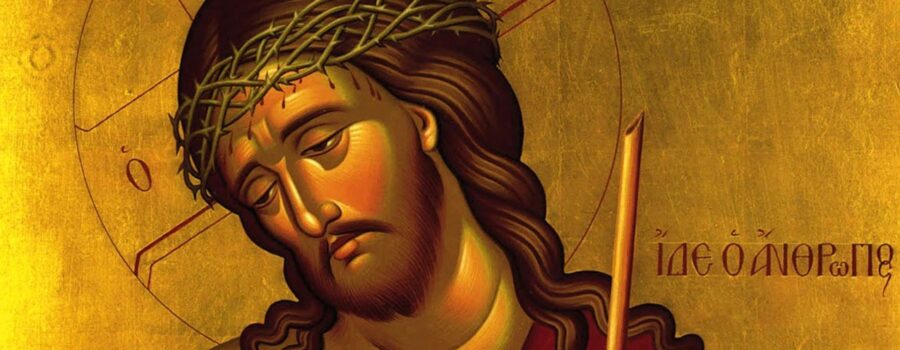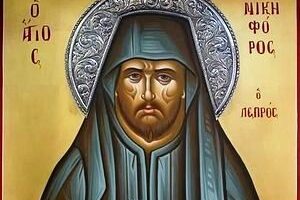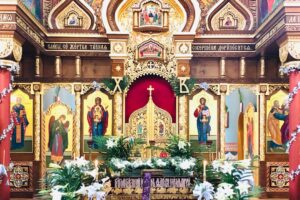The Holy Week services begin with the celebration of Christ’s entrance into Jerusalem, where He will complete His earthly ministry and complete the second purpose of His incarnation on Earth—the redemption of mankind through His death on the Cross and Bright Resurrection.
As we recall from Scripture, Jesus triumphantly entered into Jerusalem to the cheers of thousands of Jews, who thought He had come to reestablish the earthly Kingdom of Israel or, in other words, to free the Jews from the yoke of the Roman Empire. The Kingdom of God, of course, was not of this Earth at all, but the redemption of all humankind and the opening of the gates of Heaven. Because of this, the Jews’ cries of “Hosanna!” on Palm Sunday turned to “Crucify Him!” by the end of the week. In church, the services Sunday evening, Monday, and Tuesday all commemorate the last teachings of the Lord while in the Temple of Jerusalem, and privately, with His Apostles. These are extensively discussed in the Gospel according to Matthew (Ch. 21–25) and John (Ch. 12–17). Wednesday morning, we celebrate the last Presanctified Liturgy, which is celebrated only during Great Lent, commemorating the betrayal of Jesus by Judas Iscariot. Although the actual arrest of Jesus took place late Thursday night, it was on Wednesday that Judas went to the chief priests and said, “What will you give me to betray Him to you?” (Matt. 26:15). It is for this reason that we fast on every Wednesday of the year (with some exceptions).
The service on Thursday morning commemorates the Last Supper, during which Jesus uttered the words we hear at every Liturgy, “Take this and eat, this is My Body, which is broken for you for the remission of sins” (Matt 26:28–29), thereby establishing the sacrament of Holy Communion. We will be celebrating this very special Liturgy on Thursday morning of Holy Week. Thursday evening, we read the 12 Passion Gospels, which trace the events from Christ’s final conversation with His disciples during the Last Supper all the way through the burial of Jesus.
On Friday morning, the Royal Hours are read, during which several of the previous evening’s Gospel readings are repeated, commemorating the actual crucifixion of Jesus and His death on the Cross. It is for this reason that Great and Holy Friday is the strictest fasting day of the year and that we fast on Fridays throughout the rest of the year. The afternoon Vespers service with the bringing out of the Winding Sheet, or plachanitsa, follows the events of the removal of Jesus from the Cross, the lamentation of the Mother of God, and His burial in the sepulcher. That same evening, the “funeral” service for the Lord is conducted commemorating His descent into Hades and freeing all those, for whom salvation was not possible in the Old Testament prior to the coming of the Savior. This descent is marked by the procession around the church with the plachanitsa. At the end of this procession, the dark mood of Holy Friday begins to change, as the prophesies of the General Resurrection of all of mankind, written by the Prophet Jeremiah, foreshadow the coming Resurrection of Christ.
On Great and Holy Saturday, we actually begin the celebration of the Resurrection of the Lord with the Vespers service combined with the Divine Liturgy. The words “Let every creature be silent…” refer to the fact that Our Lord still lies in His tomb and that we await, with solemn anticipation, the moment of the Resurrection. On that day, in accordance with ancient traditions, the Myrrh-bearing Women did not go to the tomb and remained silent, as it was the Sabbath day. When the Sabbath was past, in other words, very early Sunday morning, the women hurried to the tomb, as they were now allowed to do so, to anoint the body of Jesus. This particular trip to the tomb of the Lord is commemorated by the midnight procession around the church at the beginning of the Paschal Matins service, the significance being that the women came to the tomb and found it empty, just as we reenter the church and no longer find the body of Jesus there, but instead, the icon of the Resurrected Christ.
Христос Воскресе! Christ is Risen! Христос Анести!
—Abbot Tryphon
All-Merciful Saviour Monastery
Vashon Island, Washington



